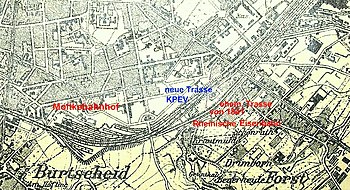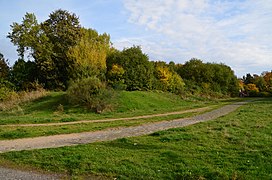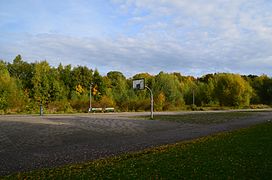Aachen freight yard
| Aachen Gbf | |
|---|---|
 Location Moltkebahnhof 1925
|
|
| Data | |
| Operating point type | Freight depot |
| Location in the network | Terminus |
| opening | April 1, 1895 |
| Conveyance | 1986 |
| location | |
| Place / district | Aachen |
| country | North Rhine-Westphalia |
| Country | Germany |
| Coordinates | 50 ° 45 '58 " N , 6 ° 6' 10" E |
| Railway lines | |
|
|
| Railway stations in North Rhine-Westphalia | |
Aachen Güterbahnhof , also known as Moltkebahnhof due to its location on Moltkestrasse , was a freight depot in the south of the city of Aachen , which was connected to the Cologne-Aachen railway via a branch line . The opening of the station took place in 1895; From the mid-1960s, the volume of goods traffic fell, so that the freight yard was closed in the mid-1990s. Today there is a park and a comprehensive school on the site.
history
Establishment
Towards the end of the 19th century, a restructuring of the rail traffic in Aachen took place after the individual private railway companies had been taken over by the Prussian State Railways . As one of several construction measures, the Moltkebahnhof was built between Aachen main station and Aachen-Rothe Erde station on the Cologne – Aachen railway line as a pure freight station in order to counteract the increasing volume of freight traffic. The connection was made via a branch line, which partly shared the embankment of the Cologne – Aachen line and branched off from this line north of the Aachen-Rothe Erde platform. The freight yard was completed in 1892, and the connection to the Rothe Erde station was completed in 1894. On April 1, 1895, the associated operating office was opened.
business
At the same time as the freight station went into operation, the freight tracks at the Marschierthor, Aachen Nord and Templerbend stations were abandoned. But as early as 1910, the new Aachen West train station was opened in the immediate vicinity of the Templerbend, which from then on took up a large part of the freight traffic, which led to a lower utilization of the Moltke station, which had no chance of expansion even because of its inner-city location. Due to the Second World War , operations at the Moltkebahnhof ceased in April 1944. Air raids caused severe damage to the track system, so that it was only possible to start up again on April 10, 1948. In the post-war period, numerous raw materials for the reconstruction of infrastructure destroyed in the war were loaded into the freight yard; a building materials trade moved into several warehouses.
On the night of September 13-14, 1958, a shunting accident occurred in which a class 50 locomotive broke through a bumper and fell onto Drimbornstrasse. The engine driver and stoker injured themselves easily when jumping off the locomotive, and the vehicle was taken out of service that same year.
Decline
Due to the increasing relocation of goods to the road, the volume of goods traffic decreased noticeably. The freight yard was used to park locomotives and wagons, as well as road vehicles for the Federal Railroad. In 1983, parts of the track system were dismantled. In 1986 the Moltkebahnhof lost its station status; From then on, the tracks were only used to operate the siding of the building materials trade, which was still on the site; Type Köf III locomotives were used for the transfer trips . This last connection was also closed between 1995 and 1997. Until 1999, most of the railway tracks in the station area were presumably stolen by metal thieves.
Reuse
Discussions about the re-use of the site began in the mid-1980s. A development with apartments, the development of commercial space or the conversion to a park were in the room. Finally, the western part was declared a commercial area, a comprehensive school was built on the middle part and the eastern part, with around half of the total area of the former train station , was made accessible to the public as the Moltkebahnhof community and youth park .
In the 1990s, on behalf of the city of Aachen, the Ecology Center Aachen in cooperation with the Institute for Ecological Consulting and Landscape Planning carried out an inventory of the flora of the industrial wasteland at the Moltebahnhof and found that a third of all species occurring in the urban area of Aachen are here find goods. Due to the high share of gravel, a microclimate developed on the site that is characterized by high heating of the topsoil. This led to the development of a rare ruderal vegetation , warmth-loving sandy and lean grass with typical species such as dyer's mignonette (Reseda luteola), yellow mignonette (Reseda lutea), St. John's wort (Hypericum perforatum) or blue snake head (Echium vulgare). Many plants and neophytes typical of the edges of railroad tracks can also be found here, such as birch (Betula) and willow (Salix caprea), small-flowered mullein (Verbascum thapsus), common evening primrose (Oenothera biennis), Canadian goldenrod (Solidago canadensis) and South African ragwort (Senecio inaequidens).
- Moltkebahnhof public and youth park
Basketball field at the location of the former track harp
Furnishing
During its operating time, the Moltkebahnhof had over 15 tracks, between which there were several loading streets and loading ramps . The goods were transported in and out via Moltkestrasse to the west and a northern access route. On the west side of the Moltke station there is still a goods hall with protruding roof windows and a two-storey brick building for goods handling ; these buildings are used by the building materials trade as storage space.
Web links
- Aerial photo of Moltkebahnhof 1977 , accessed on August 2, 2015
Individual evidence
- ↑ a b Report on the closure and reopening of stations in: newspaper of the Association of German Railway Administrations , 35th year, Berlin 1895, p. 467.
- ^ A b c Lutz-Henning Meyer: 150 years of railways in the Rhineland . Verlag JP Bachem, Cologne 1989, ISBN 3-7616-0961-2 , p. 607.
- ↑ a b c d e f g h Roland Keller: The freight yard Moltkestrasse in Aachen on guidorademacher.de , accessed on July 8, 2015.
- ↑ a b Moltkebahnhof community and youth park. Ökologie-Zentrum-Aachen eV, January 2016, accessed on April 1, 2018 .
- ↑ a b c Aachen Moltkebf. in the operational archive of nrwbahnarchiv.bplaced.net , accessed on July 14, 2015.
- ↑ a b Gaby Vetter: Green Islands - A journey of discovery in Schwedenpark and Moltkebahnhof . In: Ökologie-Zentrum Aachen (Ed.): Habitat Aachen-Umwelt discover and experience , Aachen 1994, ISBN 3-921955-22-X , p. 136ff.
- ^ Landesarchiv NRW, Rhineland Department: War destruction of the Aachen, Eschweiler and Nothberg train stations - photo book , finding aid 252.02.15 Reichsbahnbetriebsamt Aachen, signature BR 2289 No. 4
- ↑ Wilhelm Weidenhaupt: 1958 - 50 556 falls on Drimbornstrasse. Guido Radermacher's website, accessed on July 15, 2015.
- ↑ Project "Comprehensive School + Community & Youth Park." Comprehensive school website, accessed July 15, 2015.
- ↑ Institute for ecological advice and landscape planning: ecological studies for the State Garden Show 2000 in Aachen , Aachen 1992
- ↑ D. Brandes: Flora and vegetation of the railway stations of Central Europe , Pytocoenologia, Volume 11, pp. 31–115
literature
- City of Aachen, The Lord Mayor: Comprehensive School, "Moltkebahnhof" area. Announcement for the structural realization competition , Aachen 1997, (framework plan and aerial photo).
- City of Aachen, The Lord Mayor: Comprehensive school area "Moltkebahnhof". Documentation for the structural implementation competition , Aachen 1998
- City of Aachen, The Lord Mayor: Annual Report 2000. Ecological City of the Future , Aachen 2001



